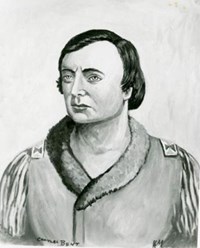- Monocacy National Battlefield (131)
- Antietam National Battlefield (84)
- Chesapeake & Ohio Canal National Historical Park (77)
- Harpers Ferry National Historical Park (75)
- Manassas National Battlefield Park (74)
- Rock Creek Park (72)
- Catoctin Mountain Park (71)
- Prince William Forest Park (68)
- National Capital Parks-East (63)
- Show More ...
- National Capital Inventory & Monitoring Network (8)
- Inventory and Monitoring Division (7)
- Eastern Rivers and Mountains Inventory & Monitoring Network (6)
- Mid-Atlantic Inventory & Monitoring Network (6)
- Natural Resource Stewardship and Science Directorate (6)
- Northeast Coastal and Barrier Inventory & Monitoring Network (5)
- Northeast Temperate Inventory & Monitoring Network (5)
- Region 1: National Capital Region (5)
- Archeology Program (3)
- Show More ...
Showing 165 results for mono ...
- Type: Article
In what is now the mesa-top Pueblo of Acoma, men with effeminate physical attributes or personal tendencies were known by many names including mujerado, qo-qoy-mo, and kokwina. They dressed and lived as women, had relationships with men, and fulfilled women's roles in the community. Much like today's queer culture, mujerados of Acoma appear to have experienced varied levels of cultural acceptance.
Charles Bent
- Type: Person
Charles Bent, alongside his partner, Ceran St. Vrain, and younger brother, William Bent, established the Bent, St. Vrain, and Company along the Santa Fe Trail in 1833. This adobe-constructed trading post beside the Arkansas River in southeastern Colorado was the first outpost between St. Louis, MO and Santa Fe, NM in its day. Charles and William's close association with Cheyenne and Arapaho nations enabled the company to prosper as a result of the buffalo robe trade.
- Type: Article
Although the abolition of slavery emerged as a dominant objective of the Union war effort, most Northerners embraced abolition as a practical measure rather than a moral cause. The war resolved legally and constitutionally the single most important moral question that afflicted the nascent republic, an issue that prevented the country from coalescing around a shared vision of freedom, equality, morality, and nationhood.
- Type: Article
Read the abstract and get the link to a published paper on a model to predict mercury risk park waterbodies: Kotalik, C.J. et al. 2025. Ecosystem drivers of freshwater mercury bioaccumulation are context-dependent: insights from continental-scale modeling. Environmental Science & Technology. DOI: 10.1021/acs.est.4c07280
Alexander Swift “Sandie” Pendleton
- Type: Person
- Type: Person
Jubal Anderson Early was Confederate General during the Civil War. Although he did not initially support secession, he fought for his native state of Virginia. Early commanded the Confederate Army of the Valley during the 1864 Shenandoah Valley Campaign. After the Civil War his speeches and writings helped promote the Lost Cause myth and white supremacy.
- Type: Article
After being mere spectators at the war's early battles, civilians both near and far from the battlefields became unwilling participants and victims of the war as its toll of blood and treasure grew year after year. In response to the hardships imposed upon their fellow citizens by the war, civilians on both sides mobilized to provide comfort, encouragement, and material, and began to expect that their government should do the same.
- Type: Article
The National Park Service will improve the ecological health of eastern forests in 38 parks using an array of management techniques. The NPS has selected forest ecosystems of high ecological and cultural value across multiple parks from Virginia to Maine that are at greatest risk of forest loss due to chronic and interacting stressors.
Marie LeFevere Bailly
- Type: Person
Part Odawa and part French, the highly respected and traditionally skilled Marie “Mo-nee” Bailly lived through rapidly changing times; she experienced shifting control over the Northwest Territory and the detrimental effects of manifest destiny on Indigenous American peoples. She resolutely oversaw the family and homestead on the Little Calumet River for more than 30 years after the death of her husband, raising their children and grandchildren in an ever-foreign world.
Worthington Farm (Clifton) Cultural Landscape
- Type: Article
The Worthington Farm, also known as Clifton, is a component landscape of Monocacy National Battlefield. Located just west of the Thomas Farm and alongside the Monocacy River, the property's patchwork of fields and woodlands represents the agricultural landscape that was present here in 1800s. The Worthington House is the only building dating to the time of the Civil War Battle of Monocacy.
Plan Like a Park Ranger 1-Day Itinerary Monocacy National Battlefield
- Type: Article
In addition to its role in the Civil War, Monocacy National Battlefield preserves and shares the stories of the many people who lived there, from Indigenous peoples, to enslaved Africans and European settlers. We have crafted an itinerary for a day trip to Monocacy, so that we can share this history with you and help you have a safe and fun trip.
Best Farm House
Antietam National Cemetery
Best Farm
- Type: Place
The quiet farm fields of the Best Farm hide deep stories of conflict and struggle. Originally known as L'Hermitage, the French-Caribbean family that sought freedom and safety here enslaved up to 90 people of African descent. During the Civil War, Union and Confederate armies took turns occupying the land; finally clashing here on July 9, 1864. This is tour stop 1 on the driving tour.




















